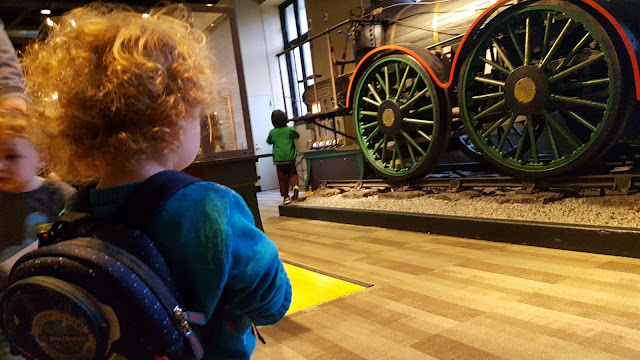Franklin Institute, NJ: Train Factory
Hobbit and I made a daytrip to Philadelphia to visit the Franklin Institute. We came for the "Polar Express" event but happily learned the Train exhibit is permanent (and well done)! I'd hoped the event would thrill my little engineer, but the trip was even better than I expected.

First, I had to see the HD Moon temporarily on display. Bonus, they had it in the Franklin Memorial and the effect was astounding. Unless you're two, then it was just meh, apparently.
However, The Baldwin 60000 blew our mind. It is a HUGE steam engine.
Across from the Baldwin 60k is The Rocket. It's a 8.4-ton steam engine built in England that ran in Philadelphia from 1838 to 1879. It was donated to the museum in 1933.
The exhibit let you try out different kinds of wheels on train tracks, and Hobbit loved it!

We stood in line to experience their Polar Express trip: a packed engine and a jaunty tune. Afterwards, an elf gives you a bell with a tag reading "the bell rings for those that truly believe".

We were the last group on, so we got to go back through without the crowd and really see the engine room.

Hobbit even got to sit in the conductor's seat. Woohoo!

This time, we could linger to see the science exhibits after you exit the engine. Hobbit was fascinated by the electromagnet. We must have done it ten times. My future engineer. 💜

Thank you, Franklin Institute, for having such a cool train exhibit!!

We couldn't go without strolling around the rest of the museum, and we found a Flying exhibit, with a jet AND a biplane hanging from the ceiling. Bonus? People can sit in the jet. So cool.

Mom even got to see some boring (cool!) old German celestial globe.


First, I had to see the HD Moon temporarily on display. Bonus, they had it in the Franklin Memorial and the effect was astounding. Unless you're two, then it was just meh, apparently.
However, The Baldwin 60000 blew our mind. It is a HUGE steam engine.
Baldwin 60000 is an experimental steam locomotive built by the Baldwin Locomotive Works in Eddystone, Pennsylvania, in 1926, during the height of the railroading industry. It received its number for being the 60,000th locomotive built by Baldwin. It weighs 350 (US) tons. The weight and length of the engine were too much for all but the heaviest and straightest tracks. In 1933, it was purchased by the Franklin Institute Science Museum for $1 and remains there today.- Wiki
 |
Hobbit was fascinated by the size of the thing. He'd seen passenger trains, but not a steam engine and certainly not this big.
 |
Across from the Baldwin 60k is The Rocket. It's a 8.4-ton steam engine built in England that ran in Philadelphia from 1838 to 1879. It was donated to the museum in 1933.
The exhibit let you try out different kinds of wheels on train tracks, and Hobbit loved it!

We stood in line to experience their Polar Express trip: a packed engine and a jaunty tune. Afterwards, an elf gives you a bell with a tag reading "the bell rings for those that truly believe".

We were the last group on, so we got to go back through without the crowd and really see the engine room.

Hobbit even got to sit in the conductor's seat. Woohoo!

This time, we could linger to see the science exhibits after you exit the engine. Hobbit was fascinated by the electromagnet. We must have done it ten times. My future engineer. 💜

Thank you, Franklin Institute, for having such a cool train exhibit!!

We couldn't go without strolling around the rest of the museum, and we found a Flying exhibit, with a jet AND a biplane hanging from the ceiling. Bonus? People can sit in the jet. So cool.

Mom even got to see some boring (cool!) old German celestial globe.

A man named Erhardt Weigel built this celestial globe near the turn of the 18th century. He was a professor of Astronomy at the University of Jena in Germany. A lamp placed in the hollow center projected light out through the small holes punched in the embossed copper sphere. The stars are represented by these small holes, and by looking into the globe through one of four larger holes, the stars are seen in their correct configuration as points of light against a dark background. Thus, the globe is the earliest known in existence of the optical planetarium. Weigel's model is dated 1699; it was acquired by The Franklin Institute in June of 1932 from Emil Hirsch of Munich, Germany. - Franklin Institute


Comments
Post a Comment